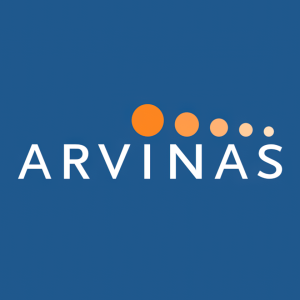Arvinas Reports First Quarter 2025 Financial Results and Provides Corporate Update
Rhea-AI Summary
Positive
- Positive Phase 3 VERITAC-2 trial results for vepdegestrant in breast cancer treatment
- Strong cash position of $954.3 million as of March 31, 2025
- Significant revenue increase to $188.8 million in Q1 2025 from $25.3 million in Q1 2024
- Cash runway extended into second half of 2028 through cost reduction measures
- Successful first-in-human data for ARV-102 showing blood-brain barrier penetration
Negative
- Removal of two Phase 3 combination trials from vepdegestrant development plan with Pfizer
- Workforce reduction of approximately one-third
- Increased R&D expenses to $90.8 million from $84.3 million year-over-year
- Higher G&A expenses at $26.6 million compared to $24.3 million in previous year
Insights
Arvinas' Phase 3 success for first PROTAC drug offsets development narrowing and workforce reduction; strong pipeline advances with extended runway.
The positive topline results from VERITAC-2 mark a watershed moment for Arvinas and the entire protein degradation field. As the first successful Phase 3 trial for a PROTAC therapy, vepdegestrant's performance in ER+/HER2- metastatic breast cancer with ESR1 mutations positions it for potential regulatory approval by late 2025/early 2026. The selection for ASCO's press program and inclusion in the "Best of ASCO" signals the clinical community's recognition of this data's significance.
However, the removal of two Phase 3 combination trials from the vepdegestrant development plan represents a strategic narrowing. Rather than pursuing a broad label across multiple breast cancer settings, Arvinas and Pfizer appear to be focusing exclusively on the second-line ESR1-mutant monotherapy opportunity. This decision likely reflects competitive pressures in the evolving metastatic breast cancer landscape and prioritization of near-term approval chances over more uncertain combination approaches.
The workforce reduction of approximately one-third alongside portfolio reprioritization indicates a significant strategic pivot. While painful, this rationalization aligns with current biotech market realities where capital efficiency is paramount. The extended cash runway into 2H 2028 provides substantial operational flexibility through potential commercialization.
Beyond vepdegestrant, Arvinas maintains a promising pipeline. The ARV-102 first-in-human data demonstrated impressive blood-brain barrier penetration with >50% LRRK2 reduction in CSF and >90% in peripheral blood, positioning it well for Parkinson's disease applications. Meanwhile, ARV-393's preclinical combination data in lymphoma and the IND clearance for ARV-806 (KRAS G12D degrader) maintain developmental momentum across multiple therapeutic areas.
Strategic realignment balances promising Phase 3 data with significant cost-cutting; cash preservation extends runway while development focus narrows.
Arvinas has implemented a strategic realignment that balances promising clinical progress with aggressive cost containment. The workforce reduction of approximately one-third reflects management's pragmatic response to challenging biotech capital markets, trading near-term pain for extended operational viability. This restructuring, combined with the elimination of two costly Phase 3 trials, has successfully extended the cash runway into 2H 2028 - a remarkable 3+ year window that exceeds most peers in the development-stage biotech sector.
The $954.3 million cash position represents a $85.1 million decrease from year-end 2024 ($1,039.4 million), with burn primarily driven by R&D operations. While quarterly expenses increased modestly year-over-year (R&D: $90.8M vs $84.3M; G&A: $26.6M vs $24.3M), these figures don't yet reflect the announced cost reductions, which should significantly improve future burn rates.
The dramatic revenue increase to $188.8 million (vs $25.3M in Q1 2024) warrants clarification - this primarily reflects accounting adjustments from the Pfizer collaboration following development plan changes rather than actual cash receipts. The removal of two Phase 3 trials altered the timeline and cost structure of the collaboration, triggering this revenue recognition.
From a valuation perspective, the narrowed development strategy for vepdegestrant creates competing considerations: potential faster time-to-market in the second-line ESR1-mutant setting versus a reduced addressable market by foregoing broader combination approaches. However, the positive Phase 3 data significantly de-risks the lead program, while the extended runway provides flexibility to weather potential regulatory or commercial challenges without immediate financing pressure.
– Reported positive topline results from the Phase 3 VERITAC-2 trial that support global regulatory filings –
– Presented first-in-human data for the Company’s first neuroscience program with ARV-102 showing blood-brain barrier penetration and central and peripheral LRRK2 degradation –
– Announced the re-prioritization of its vepdegestrant development plan and research portfolio and initiated cost reductions, including a workforce reduction of approximately one-third, to extend the Company’s cash runway into the second half of 2028 –
– Company to host conference call today at 8:00 a.m. ET –
NEW HAVEN, Conn., May 01, 2025 (GLOBE NEWSWIRE) -- Arvinas, Inc. (Nasdaq: ARVN), a clinical-stage biotechnology company working to develop a new class of drugs based on targeted protein degradation, today reported financial results for the first quarter ended March 31, 2025, and provided a corporate update.
“The positive readout from our first Phase 3 trial, the first ever for a PROTAC, is a tremendous accomplishment and one which we are very proud of,” said John Houston, Ph.D., Chairperson, Chief Executive Officer and President at Arvinas. “Our conviction is high that vepdegestrant can be highly competitive as a monotherapy treatment option for metastatic breast cancer in the second-line, ESR1 mutant setting. We are on track to submit a regulatory filing with health authorities, which we believe could result in the first ever approval of a PROTAC and an exciting opportunity to bring a novel treatment to patients with ESR1 mutant advanced metastatic breast cancer.”
“Beyond the second-line monotherapy opportunity, we and our partners at Pfizer have removed plans for a Phase 3 first-line combination trial with atirmociclib, as well as the planned Phase 3 second-line combination trial with a CDK4/6 inhibitor, from our joint development plan,” continued Dr. Houston. “This decision was made following a review of the totality of emerging information, including external data results, the evolving treatment landscape in metastatic breast cancer, and long-term capital allocation. We and Pfizer are working to evaluate future combination plans with the potential to maximize patient benefit and shareholder value.”
1Q 2025 Business Highlights and Recent Developments
Vepdegestrant: Oral PROTAC ER degrader: As part of Arvinas global collaboration with Pfizer, the companies:
- Reported positive topline data for VERITAC-2, the Phase 3 pivotal 2L+ trial of monotherapy vepdegestrant in patients with estrogen receptor-positive, human epidermal growth factor receptor 2-negative (ER+/HER2-) advanced or metastatic breast cancer, in the estrogen receptor 1-mutant population.
- VERITAC-2 data accepted for oral presentation at the 2025 American Society of Clinical Oncology (ASCO) Annual Meeting (May 30 – June 3, 2025).
- Announced that Pfizer will add a vepdegestrant/KAT6 cohort to its ongoing Phase 1 trial evaluating its investigational KAT6 inhibitor (PF-07248144) in combination with endocrine therapies following CDK4/6 inhibitor treatment.
- Removed the first-line Phase 3 combination trial with Pfizer’s novel investigational CDK4 inhibitor, atirmociclib, from the agreed-upon joint development plan.
- Removed the second-line Phase 3 combination trial with a CDK4/6 inhibitor from the agreed-upon joint development plan.
ARV-102: Oral PROTAC LRRK2 degrader
- Presented single ascending dose (SAD) and multiple ascending dose (MAD) data from the ongoing Phase 1 clinical trial in healthy volunteers in an oral session at the Alzheimer’s Disease/Parkinson’s Disease (AD/PD) conference in Vienna, Austria demonstrating blood-brain barrier penetration, and central and peripheral LRRK2 degradation:
- At a single oral dose of at least 60 mg, and once daily repeated oral doses of at least 20 mg, ARV-102 achieved greater than
50% LRRK2 reduction in the cerebral spinal fluid (CSF) and greater than90% LRRK2 reduction in the peripheral blood mononuclear cells (PBMCs), indicating substantial central and peripheral LRRK2 protein degradation. - Inhibition of Rab10 phosphorylation in PBMCs and reduction of bis(monoacylglycerol)phosphate (BMP) in urine following single doses of ARV-102, signifying downstream LRRK2 pathway engagement.
- Bioavailable and brain penetrant with dose dependent exposure in the CSF.
- ARV-102 was generally safe and well tolerated with no serious adverse events reported after single or multiple doses.
- At a single oral dose of at least 60 mg, and once daily repeated oral doses of at least 20 mg, ARV-102 achieved greater than
ARV-393: Oral PROTAC BCL6 degrader
- Continued recruiting patients in the first-in-human Phase 1 clinical trial in patients with non-Hodgkin lymphoma (NHL) (ClinicalTrials.gov Identifier: NCT06393738).
- Presented new preclinical data of ARV-393 in combination with standard of care (SOC) biologic agents and small molecule inhibitors (SMI) in high-grade B-cell lymphoma (HGBCL) and aggressive diffuse large B-cell lymphoma (DLBCL) models at the American Association for Cancer Research Annual Meeting demonstrating that ARV-393 had broad and significant combinability with:
- SOC chemotherapy:
- ARV-393 in combination with R-CHOP, induced significantly greater tumor growth inhibition (TGI) compared with rituximab, CHOP, R-CHOP, or ARV-393 alone, with complete tumor regressions enabled by the combination.
- SOC biologics:
- Similarly, the combination of ARV-393 and SOC biologics targeting CD19 (tafasitamab), CD79b (polatuzumab vedotin), or CD20 (rituximab) resulted in tumor regressions and demonstrated significantly stronger TGI compared with either agent alone.
- Investigational small molecule inhibitors targeting clinically validated oncogenic drivers of lymphoma:
- Combination of ARV-393 with a BTK inhibitor (acalabrutinib), a BCL2 inhibitor (venetoclax), or an EZH2 inhibitor (tazemetostat) induced tumor regressions in the majority of mice.
- SOC chemotherapy:
- Overall, current preclinical data suggest that ARV-393 has the potential to be an attractive combination partner for development of novel therapies for lymphoma, including chemo-free combination regimens and/or “all oral” treatment options.
ARV-806: Novel PROTAC KRAS G12D degrader
- Filed an Investigational New Drug (IND) application and received a safe-to-proceed letter from the U.S. Food and Drug Administration.
Corporate updates:
As part of a Company-wide cost reduction effort:
- Announced the removal of two Phase 3 trials from the vepdegestrant development plan
- Announced a reduction in workforce of approximately one-third across the Company to streamline operations across the organization and enable the efficient progression of the Company’s portfolio. The reduction is planned to be completed in the second quarter of 2025.
- Announced a reprioritization of the Company’s preclinical portfolio to focus on assets that have the greatest potential to deliver value for patients, physicians and shareholders.
- Updated guidance for its cash runway into the second half of 2028.
“We continuously evaluate and refine our long-term strategy, and recent challenges in the capital markets have required us to expeditiously evaluate our business priorities and capital needs,” continued Dr. Houston. “Although difficult, the workforce reduction is a prudent decision that we believe will right-size the Company for future success. I want to thank all the talented employees who were directly impacted by this decision. I’m proud of the progress we have made together, and want to acknowledge their contributions, and commitment, to discovering and developing new treatment options for patients with serious diseases.”
Anticipated Upcoming Milestones and Expectations
Vepdegestrant: Oral PROTAC ER degrader
As part of Arvinas’ global collaboration with Pfizer, the companies plan to:
- Present detailed results from the VERITAC-2 Phase 3 clinical trial in a late-breaker oral presentation at ASCO (2Q 2025).
- VERITAC-2 abstract will be featured in the ASCO press program and has been selected to be included in the “2025 Best of ASCO Program.”
- Share data with global regulatory authorities to potentially support regulatory filings (2Q 2025) and submit new drug application to the U.S. Food and Drug Administration for potential approval (2H 2025).
- Add a combination cohort of vepdegestrant plus Pfizer’s KAT6 inhibitor (PF-07248144) to Pfizer’s ongoing Phase 1 trial (NCT04606446).
- The trial is currently evaluating Pfizer’s KAT6 inhibitor in combination with endocrine therapies following CDK4/6 inhibitor treatments; the trial is being operationalized and funded by Pfizer.
- The trial is currently evaluating Pfizer’s KAT6 inhibitor in combination with endocrine therapies following CDK4/6 inhibitor treatments; the trial is being operationalized and funded by Pfizer.
ARV-102: Oral PROTAC LRRK2 degrader
- Present final data from the SAD/MAD cohorts of the Phase 1 clinical trial in healthy volunteers (2H 2025).
- Continue enrollment and present initial data from the SAD cohort of the ongoing Phase 1 clinical trial in patients with Parkinson’s disease (2H 2025).
- Initiate the MAD cohort of the Phase 1 clinical trial in patients with Parkinson’s disease (2H 2025).
ARV-393: Oral PROTAC BCL6 degrader
- Present new preclinical data demonstrating single agent activity of ARV-393 in patient derived xenograft models of transformed Follicular Lymphoma and a patient-derived xenograft model of nTFHL-AI (angioimmunoblastic type of nodal T-follicular helper cell lymphoma), a rare and aggressive non-Hodgkin lymphoma with high unmet need and limited treatment options, at the European Hematology Association 2025 conference in Milan, Italy (June 12-15, 2025).
- Share preclinical data in combination with an emerging SOC option in 2L DLBCL (2H 2025).
- Share preliminary clinical data from the ongoing Phase 1 clinical trial in patients with NHL (NCT06393738) (2H 2025).
ARV-806: Novel PROTAC KRAS G12D degrader
- Initiate a first-in-human Phase 1 trial in patients with solid tumors harboring KRAS G12D mutations (2H 2025).
Financial Guidance
Based on its current operating plan, Arvinas believes its cash, cash equivalents, and marketable securities as of March 31, 2025, is sufficient to fund planned operating expenses and capital expenditure requirements into the second half of 2028.
First Quarter Financial Results
Cash, Cash Equivalents, and Marketable Securities Position: As of March 31, 2025, cash, cash equivalents and marketable securities were
Research and Development Expenses: Generally Accepted Accounting Principles (GAAP) Research and development (R&D) expenses were
Non-GAAP R&D expenses were
General and Administrative Expenses: GAAP General and administrative (G&A) expenses were
Non-GAAP G&A expenses were
Revenue: Revenue was
Investor Call & Webcast Details
Arvinas will host a conference call and webcast today, May 1, 2025, at 8:00 a.m. ET to review its first quarter 2025 financial results and discuss recent corporate updates. Participants are invited to listen by going to the Events and Presentation section under the Investors page on the Arvinas website at www.arvinas.com. A replay of the webcast will be available on the Arvinas website following the completion of the event and will be archived for up to 30 days.
About Arvinas
Arvinas (Nasdaq: ARVN) is a clinical-stage biotechnology company dedicated to improving the lives of patients suffering from debilitating and life-threatening diseases. Through its PROTAC (PROteolysis Targeting Chimera) protein degrader platform, Arvinas is pioneering the development of protein degradation therapies designed to harness the body’s natural protein disposal system to selectively and efficiently degrade and remove disease-causing proteins. Arvinas is currently progressing multiple investigational drugs through clinical development programs, including vepdegestrant, targeting the estrogen receptor for patients with locally advanced or metastatic ER+/HER2- breast cancer; ARV-393, targeting BCL6 for relapsed/refractory non-Hodgkin Lymphoma; and ARV-102, targeting LRRK2 for neurodegenerative disorders. Arvinas is headquartered in New Haven, Connecticut. For more information about Arvinas, visit www.arvinas.com and connect on LinkedIn and X.
About Vepdegestrant
Vepdegestrant is an investigational, orally bioavailable PROTAC protein degrader designed to specifically target and degrade the estrogen receptor (ER) for the treatment of patients with ER positive (ER+)/human epidermal growth factor receptor 2 (HER2) negative (ER+/HER2-) breast cancer. Vepdegestrant is being developed as a potential monotherapy and as part of combination therapy across multiple treatment settings for ER+/HER2- metastatic breast cancer.
In July 2021, Arvinas announced a global collaboration with Pfizer for the co-development and co-commercialization of vepdegestrant; Arvinas and Pfizer will share worldwide development costs, commercialization expenses, and profits.
The U.S. Food and Drug Administration (FDA) has granted vepdegestrant Fast Track designation as a monotherapy in the treatment of adults with ER+/HER2- locally advanced or metastatic breast cancer previously treated with endocrine-based therapy.
About ARV-102
ARV-102 is an investigational, orally bioavailable and brain-penetrant PROTAC protein degrader designed to specifically target and degrade leucine-rich repeat kinase 2 (LRRK2), which is a large, multidomain scaffolding kinase. Increased activity and expression of LRRK2 have been implicated in the pathogenesis of neurological diseases, including LRRK2 genetic and idiopathic Parkinson’s disease and progressive supranuclear palsy.
About ARV-393
ARV-393 is an investigational, orally bioavailable PROTAC designed to specifically target and degrade B-cell lymphoma 6 protein (BCL6), a transcriptional repressor and major driver of B-cell lymphomas. During B-cell development, tightly controlled BCL6 protein expression regulates >600 genes to facilitate rapid B-cell proliferation and tolerance of somatic hypermutation and gene recombination for antibody generation. Deregulated BCL6 expression is common in B-cell lymphoma and promotes cancer cell survival, proliferation, and genomic instability. PROTAC-mediated degradation has the potential to address the historically undruggable nature of BCL6. ARV-393 is currently in a Phase 1 clinical trial in patients with relapsed/refractory non-Hodgkin lymphoma.
Non-GAAP Financial Information
The results presented in this press release include both Generally Accepted Accounting Principles (GAAP) information and non-GAAP information. As used in this release, non-GAAP research and development (“R&D”) expense is defined by Arvinas as GAAP R&D expense excluding stock-based compensation expense, and non-GAAP general and administrative (“G&A”) expense is defined by Arvinas as GAAP G&A expense excluding stock-based compensation expense. Arvinas uses these non-GAAP financial measures to evaluate Arvinas’ ongoing operations and for internal planning and forecasting purposes. Arvinas believes that non-GAAP financial information, when taken collectively, may be helpful to investors because it provides consistency and comparability with past financial performance. However, non-GAAP financial information is presented for supplemental informational purposes only, has limitations as an analytical tool, and should not be considered in isolation or as a substitute for financial information presented in accordance with GAAP. Other companies, including companies in Arvinas’ industry, may calculate similarly titled non-GAAP measures differently or may use other measures to evaluate their performance, all of which could reduce the usefulness of Arvinas’ non-GAAP financial measures as tools for comparison. Investors are encouraged to review the related GAAP financial measures and the reconciliation of these non-GAAP financial measures to their most directly comparable GAAP financial measures and not rely on any single financial measure to evaluate Arvinas’ business.
Forward-Looking Statements
This press release contains forward-looking statements within the meaning of The Private Securities Litigation Reform Act of 1995 that involve substantial risks and uncertainties, including statements regarding: Arvinas’ belief that vepdegestrant can be highly competitive as a monotherapy treatment option for metastatic breast cancer in the second-line, estrogen receptor 1-mutant setting; Arvinas’ plans and timing to submit a regulatory filing with health authorities for vepdegestrant, and Arvinas’ belief that could result in the first ever approval of a PROTAC and an opportunity to bring a novel treatment to patients with ESR1-mutant advanced metastatic breast cancer; our evaluation, with Pfizer, Inc. (“Pfizer”), of future vepdegestrant combination plans, with the potential to maximize patient benefit and shareholder value; the potential for ARV-393 to be an attractive combination partner for development of novel therapies for lymphoma, including chemo-free combination regimens and/or “all oral” treatment options; Arvinas’ workforce reduction plans; Arvinas’ plans, as part of its global collaboration with Pfizer to present results from the VERITAC-2 Phase 2 clinical trial in a late-breaker oral presentation at the 2025 American Society of Clinical Oncology Annual Meeting and share data with global regulatory authorities to potentially support regulatory filings and submit new drug application to the U.S. Food and Drug Administration for potential approval, and timing thereof; Arvinas’ plans to present final data from the single ascending dose (“SAD”) and multiple ascending dose (“MAD”) cohorts of the Phase 1 ARV-102 clinical trial in healthy volunteers, and timing thereof; Arvinas’ plans to continue enrollment and present initial data from the SAD cohort of the ongoing Phase 1 ARV-102 clinical trial in patients with Parkinson’s disease (“PD”), and timing thereof; Arvinas’ plans to initiate the MAD cohort of the Phase 1 ARV-102 clinical trial in patients with PD, and timing thereof; Arvinas' plans to present new preclinical data demonstrating single agent activity of ARV-393 in patient derived xenograft models of transformed Follicular Lymphoma and a patient-derived xenograft model of nTFHL-AI (angioimmunoblastic type of nodal T-follicular helper cell lymphoma) at the European Hematology Association 2025 conference in Milan, Italy; Arvinas’ plans to share ARV-393 preclinical data in combination with an emerging standard of care option in second-line diffuse large B-cell lymphoma, and timing thereof; Arvinas’ plans to share preliminary clinical data from the ongoing ARV-393 Phase 1 clinical trial in patients with Non-Hodgkin Lymphoma, and timing thereof; Arvinas’ plans to initiate a first-in-human Phase 1 trial of ARV-806 in patients with solid tumors harboring Kirsten rat sarcoma G12D mutations, and timing thereof; and statements regarding Arvinas’ cash, cash equivalents and marketable securities, including their sufficiency to fund planned operating expenses and capital expenditure requirements into the second half of 2028.
All statements, other than statements of historical fact, contained in this press release, including statements regarding Arvinas’ strategy, future operations, future financial position, future revenues, projected costs, prospects, plans and objectives of management, are forward-looking statements. The words “anticipate,” “believe,” “estimate,” “expect,” “intend,” “may,” “might,” “plan,” “predict,” “project,” “target,” “goal,” “potential,” “will,” “would,” “could,” “should,” “continue,” and similar expressions are intended to identify forward-looking statements, although not all forward-looking statements contain these identifying words.
Arvinas may not actually achieve the plans, intentions or expectations disclosed in these forward-looking statements, and you should not place undue reliance on such forward-looking statements. Actual results or events could differ materially from the plans, intentions and expectations disclosed in the forward-looking statements Arvinas makes as a result of various risks and uncertainties, including but not limited to: whether Arvinas and Pfizer will successfully perform their respective obligations under the collaboration between Arvinas and Pfizer; whether Arvinas and Pfizer will be able to successfully conduct and complete clinical development for vepdegestrant; whether Arvinas will be able to successfully conduct and complete development for its other product candidates, including ARV-393 and ARV-102, and including whether Arvinas initiates and completes clinical trials for its product candidates and receives results from its clinical trials and preclinical studies on its expected timelines or at all; whether Arvinas and Pfizer, as appropriate, will be able to obtain marketing approval for and commercialize vepdegestrant and other product candidates on current timelines or at all; Arvinas’ ability to protect its intellectual property portfolio; Arvinas’ reliance on third parties; risks associated with Arvinas’ ability to successfully implement its workforce reduction plan; the risk that Arvinas’ workforce reduction may affect Arvinas’ ability to retain skilled and motivated personnel and may be distracting to employees and management; the impact of the workforce reduction on the Company’s business and reputation; whether Arvinas will be able to raise capital when needed; whether Arvinas’ cash and cash equivalent resources will be sufficient to fund its foreseeable and unforeseeable operating expenses and capital expenditure requirements; and other important factors discussed in the “Risk Factors” section of Arvinas’ Annual Report on Form 10-K for the year ended December 31, 2024 and subsequent other reports on file with the U.S. Securities and Exchange Commission. The forward-looking statements contained in this press release reflect Arvinas’ current views with respect to future events, and Arvinas assumes no obligation to update any forward-looking statements, except as required by applicable law. These forward-looking statements should not be relied upon as representing Arvinas’ views as of any date subsequent to the date of this release.
Contacts
Investors:
Jeff Boyle
+1 (347) 247-5089
Jeff.Boyle@arvinas.com
Media:
Kirsten Owens
+1 (203) 584-0307
Kirsten.Owens@arvinas.com
| Arvinas, Inc. | |||||||
| Condensed Consolidated Balance Sheets (Unaudited) | |||||||
| (dollars and shares in millions, except per share amounts) | March 31, 2025 | December 31, 2024 | |||||
| Assets | |||||||
| Current assets: | |||||||
| Cash and cash equivalents | $ | 81.0 | $ | 100.5 | |||
| Marketable securities | 873.3 | 938.9 | |||||
| Accounts receivable | 0.4 | 5.7 | |||||
| Other receivables | 8.0 | 8.0 | |||||
| Prepaid expenses and other current assets | 17.0 | 14.2 | |||||
| Total current assets | 979.7 | 1,067.3 | |||||
| Property, equipment and leasehold improvements, net | 6.7 | 7.0 | |||||
| Operating lease right-of-use assets | 9.9 | 9.0 | |||||
| Collaboration contract asset and other assets | 4.8 | 8.1 | |||||
| Total assets | $ | 1,001.1 | $ | 1,091.4 | |||
| Liabilities and stockholders' equity | |||||||
| Current liabilities: | |||||||
| Accounts payable and accrued liabilities | $ | 71.1 | $ | 71.8 | |||
| Deferred revenue | 141.0 | 156.2 | |||||
| Current portion of operating lease liabilities | 1.9 | 1.8 | |||||
| Total current liabilities | 214.0 | 229.8 | |||||
| Deferred revenue | 118.4 | 292.0 | |||||
| Long-term debt | 0.5 | 0.6 | |||||
| Operating lease liabilities | 8.1 | 7.3 | |||||
| Total liabilities | 341.0 | 529.7 | |||||
| Stockholders’ equity: | |||||||
| Preferred stock, | — | — | |||||
| Common stock, | 0.1 | 0.1 | |||||
| Accumulated deficit | (1,448.7 | ) | (1,531.6 | ) | |||
| Additional paid-in capital | 2,107.2 | 2,092.2 | |||||
| Accumulated other comprehensive income | 1.5 | 1.0 | |||||
| Total stockholders’ equity | 660.1 | 561.7 | |||||
| Total liabilities and stockholders’ equity | $ | 1,001.1 | $ | 1,091.4 | |||
| Arvinas, Inc. | |||||||
| Condensed Consolidated Statements of Operations (Unaudited) | |||||||
| For the Three Months Ended March 31, | |||||||
| (dollars and shares in millions, except per share amounts) | 2025 | 2024 | |||||
| Revenue | $ | 188.8 | $ | 25.3 | |||
| Operating expenses: | |||||||
| Research and development | 90.8 | 84.3 | |||||
| General and administrative | 26.6 | 24.3 | |||||
| Total operating expenses | 117.4 | 108.6 | |||||
| Income (loss) from operations | 71.4 | (83.3 | ) | ||||
| Interest and other income | 11.7 | 14.0 | |||||
| Net income (loss) before income taxes | 83.1 | (69.3 | ) | ||||
| Income tax expense | (0.2 | ) | (0.1 | ) | |||
| Net income (loss) | $ | 82.9 | $ | (69.4 | ) | ||
| Earnings (loss) per common share | |||||||
| Basic | $ | 1.14 | $ | (0.97 | ) | ||
| Diluted | $ | 1.14 | $ | (0.97 | ) | ||
| Weighted average common shares outstanding | |||||||
| Basic | 72.5 | 71.7 | |||||
| Diluted | 72.7 | 71.7 | |||||
| Arvinas, Inc. | |||||
| Reconciliation of GAAP to Non-GAAP Information | |||||
| For the Three Months Ended March 31, | |||||
| (dollars and shares in millions, except per share amounts) | 2025 | 2024 | |||
| Research and development reconciliation | |||||
| GAAP research and developments | 90.8 | 84.3 | |||
| Less: stock-based compensation expense | 11.5 | 12.4 | |||
| Non-GAAP research and development expenses | $ | 79.3 | $ | 71.9 | |
| General and administrative reconciliation | |||||
| GAAP general and administrative expenses | 26.6 | 24.3 | |||
| Less: stock-based compensation expense | 3.5 | 6.3 | |||
| Non-GAAP general and administrative expenses | $ | 23.1 | $ | 18.0 | |







